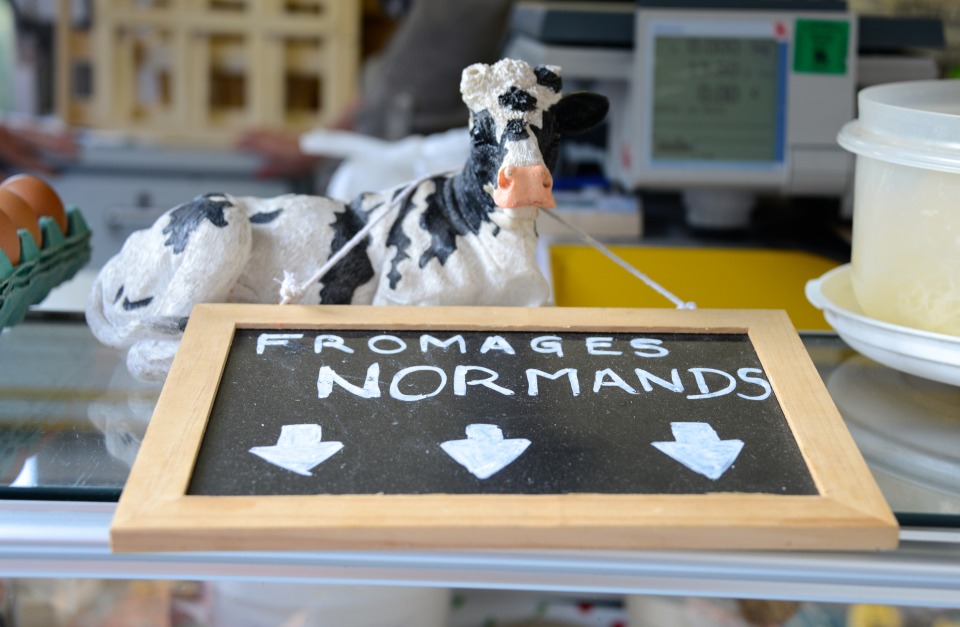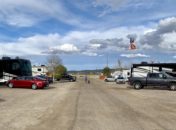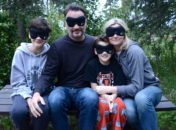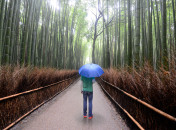ESCAPE FROM PARIS
After picking up our rental car at Gare du Nord and navigating a mid-size station wagon out of a compact size parking spot and up an economy size ramp, we burst out onto the streets of Paris with the sole intent of escaping it for Normandy. If you’ve driven in a major city such as New York or Chicago, you know how turbulent it can be. Well, Paris is worse. A lot worse. It is a mass of distracted drivers competing with pods of bicycles and herds of mopeds all weaving through the city. Paris pedestrians are like matadors daring vehicles to clip them as they pass. I was one among a spooked flock of starlings, all swirling one way then reversing course at the traffic circle where the drivers seem to follow a collective philosophy regarding right-of-way. I didn’t get it, but slowly learned to let go of logic and just be one with the road.
With Angela as my rockstar navigator and the boys wisely staying quiet, we finally exited the tunnel under La Défense and zoomed out along the A14. Then the A14 became the A13 toll road that must have cost us nearly $100 to reach our destination in Bayeux. It did give us a rare opportunity to find an easy lunch spot – McDonald’s just off the motorway. I won’t be providing a restaurant review but suffice it to say it was a predictable meal and one that made the boys happy.
ARRIVING NORMANDY
We arrived in Bayeux to a town festooned with flags, threaded on lines across the narrow streets and painted into the broad storefront windows. In addition to the French banner , British, Canadian and American flags hung proudly – proof that we’d arrived near the beaches of Normandy, site of the historic D-Day Invasion. June 2014 was the 70th anniversary of the invasion that led to the liberation of France from the Nazis, and many tourists in town were perhaps sons and daughters of those who fought. I don’t know whether Bayeux is always decorated as such or if it was in honor of the anniversary, but it was neat to see.
Bayeux is as beautiful a French town as you’ll ever find. Sure, it is a tourist destination and as such must cater to that economic demand – shops sell gobs of refrigerator magnets, postcards and locally produced schtuff. But it seems to have found a nice balance between its heart and its face. A quick stop in the Tourist Information office and we were set for the next few days.
HISTORY IN EMBROIDERY
Our first stop was the Bayeux Tapestry, a 230-foot long elaborately embroidered cloth that details the Norman conquest of England. On the walk through the village over to the Musée de la Tapisserie de Bayeux exhibit, Angela spoke briefly with a Canadian family near the Churchill Hotel. They were traveling with their older kids (20s and 30s) and seemed intrigued by our journey.
The breeze carried fragrances of summer transitioning into fall, and our path was bordered with parks and benches; flowers and fruit trees. Inside the museum was very dark, with only the tapestry illuminated. Our audio guide (an iPod on a lanyard) provided a narrated history. It did not have a pause button and moved rather briskly; clearly the intent was to stream through visitors as quickly as possible. The guide was well done and critical to understanding the detail and importance of the Norman Conquest. I’d recommend the Tapestry, as it was one of the more interesting and historically significant activities of our travels. The gift shop was significant too as it was where we purchased wooden broadswords for our sons and their friends we’d be visiting in Switzerland.
The Logis de Saint Jean was our home for three nights in Bayeux. We had a great two-bedroom apartment – upstairs for Angela and me, downstairs for the boys. Angela and I were constantly ducking below our sloped ceiling, but it made the place cozy. The 400-year old building is wedged in the town center and close to everything in Bayeux, but is set quietly off the street with a peaceful courtyard. Each morning, the owner and our host Valerie would prepare breakfast and then join us in discussing our upcoming day, offering helpful advice and recommendations.
Every town seems to have an Irish Pub. After a long day of driving, Bayeux’s Pub gave me an opportunity for a pint while reading Moby Dick on my Kindle. I was waiting for restaurants to open and then Angela and the boys would join me for dinner. However, Ronan fell deeply asleep in the room, so Angela brought Asher to the pub and he and I went to dinner alone.
We found an Italian joint down the street and had no problem getting a table. It was definitely touristy as the French owner wore an American flag polo shirt. The walls were covered in black and white D-Day photos, with lots of American, Canadian and British flag-waving locals. Asher and I talked about history and I shared stories of my grandfather who fought in WWII and was part of the North African invasion, which informed much of the planning for D-Day. Next to us, a family from Dallas started up a conversation and shared recommendations for our Normandy beaches tour the following day.
Back at the inn, Asher and I delivered cheese pizza to a now awake Ronan and a hungry Angela.
DRIVE THROUGH HISTORY
After breakfast and loaded with recommendations from Valerie, we headed northeast for the first of many stops. Irrespective of historic significance, the drive was gorgeous, with broad rolling pastures and ancient stone barns. We passed tiny high-walled towns and tractors slugging along the winding roads. The landscape is so idyllic and shows remarkably little sign of the massive military operations executed across it 70 years ago. This part of France revealed no horrors or tragedies upon its impassive fields and gardens, but rather did only what it has done for hundreds of years – it fed.
Our first stop was 15km away in the town of Arromanches-les-Bains, referred to simply as Arromanches. Geographically, Arromanches sits at the heart of the D-Day Invasion region. We learned that winning this position was critical to the Allies as it established an artificial port to supply arms, fuel and food without needing control of the deep-water ports of Le Havre and Cherbourg. It is in the midst of Gold Beach, a British military objective, so the Tricolore (France) and the Union Jack (UK) were flying everywhere. We walked along the seawall and looked at the enormous field artillery, half-tracks and other equipment scattered along the beach.
Our next stop was the German artillery battery at Longue-sur-Mer, on the boundary between the Omaha (US) and Gold (UK) beaches. We explored the four 152mm gun placements, which are in various states of destruction and show grenade damage and bullet impacts. The several-feet-thick concrete casemates convey just how important this position was to the Nazis to (unsuccessfully) hold the Atlantic Wall. The battery is surrounded by fields of hay and wheat, and in one we could see where a farmer was working around a large chunk of concrete left over from the war.
That morning, we had stopped at the market and picked up a baguette, cheese, local apples, drinks and of course, chocolate. For our picnic we drove down the road to Port-en-Bessin-Huppain, where we sat in the car out of the rain and enjoyed lunch overlooking the fishing ships. The famous Normandy apples were among the best we’ve ever tasted. We also had picked up a couple of local double-crème cheeses at the Farmer’s Market to take to friends in Switzerland. Great cheeses stink and these must have been really great cheeses. Over the course of the day our car became increasingly pungent, which the boys sourced for many jokes and accusations.
Down a beautiful but non-descript road near the town of Colleville-sur-Mer, we arrived at the Normandy American Cemetery and Memorial. The Cemetery is the most moving American war memorial I have ever visited. Walking the grounds of this holy place where young men so faithfully committed themselves to empathy, liberty and sacrifice, you realize that these ideals transcend nationalities and religions. On a rise overlooking Omaha Beach there are over 9,000 remains permanently interred beneath white stone crosses and Stars of David. Even today, that broad stretch of sand leading up to an advantaged military position looks like folly to anyone trying to take it. One had to believe in something greater in order to even try.
Inside the memorial museum, we were further moved by the displays, videos and personal stories that bring the significance of D-Day (and WWII) into clearer focus. It was a deeply emotional experience for all of us.
Although tired, we had one more visit to make along the Normandy coast – the battery on a promontory at Pointe du Hoc. The Pointe was a costly position for the U.S. Army Rangers as first they had to scale 100ft vertical cliffs to reach the position. In the two-day assault, the American commando force of 225 men was reduced to only 90. Pointe du Hoc reveals the violence still 70 years later, where blast craters several meters deep pock the Nazi’s prized position on the Atlantic Wall. On the way back to Bayeux, we talked with the boys about what we’d seen and tried to imagine the hardships endured by soldiers and residents during WWII.
CAN WE STAY?
On our final day in Bayeux we were rather worn out from the previous day touring the coast and absorbing so much history, so we mostly did schoolwork with the boys and walked the town visiting shops. The intent was to find a brasserie meal for dinner, but we were too early (again) and ended up at Pizza e Pasta instead. They served the best pizza we’d had on the trip, and after complimenting the chef he sent us a bottle of Limoncello and bowl of candies.
We didn’t want to leave Bayeux. It is a fantastic place, with great people in a beautiful setting. After saying necessary goodbyes to Valerie, we drove back through Colleville-sur-Mer and stopped at the Overlord Museum, which features German, U.S., British, Australian/NZ and Canadian military equipment and uniforms as well as radios and machines used by the French Resistance. Their presentation was informative and gave the boys and me a chance to talk more about the war.
Leaving Normandy we were more strategic about our route, doing everything we could to avoid toll roads and major motorways. As we reached Mont Saint-Michel, we paused for another picnic of bread, cheese and chocolates before heading to the commune. A shuttle dropped us just beneath the rising island. Inside the gates we climbed the steps and wove through cobblestone streets to the base of the Abbey. MSM is a lovely and unique UNESCO World Heritage Site, but to be honest felt a bit Disney-fied, with too many postcard shops and “medieval” pubs. Plus once you’re inside the village, the dramatic view of the island rising from the tidal basin is lost. We tried to make the most of the journey by trekking the two miles back to the parking lot. Except for a dense and sudden swarm of mosquitos near the car, it was a nice walk and at least we avoided the very real quicksand of the basin.
BRETON PRIDE
It was nearly nightfall when we arrived in the walled Breton town of Dinan. Despite a few sharp turns and missed traffic circle exit, we finally curved around the outside of the walls and past a ruined gate to the Hôtel De La Porte Saint Malo. After checking in we braved the town’s cambered and worn cobblestone streets for a warm meal and cold drinks at Le Cosy Grill.
Although Brittany borders Normandy, it is quite different in character. The citizens are known for associating more strongly with their region than with France as a whole, and the Breton flag is proudly flown on apartments, shops and cafes (and even in the most unlikely of places, see gallery photo).
Most of Dinan was built over 500 years ago. The town is featured in the Bayeux Tapestry we’d seen a few days prior, and the Theatre des Jacobins was constructed in 1224. Some town buildings lean while others support their neighbors against collapse. When originally built, property taxes were calculated based on street-level square footage, so several structures look like funnels, with higher floors leaning out over the base.
We spent a warm morning ambulating the ramparts of the old town. The first stretch rose high above the twisting River Rance and afforded beautiful views of the valley. The boys spent time pretending they were tower guards. As we moved along the walls, updates to the castle were revealed through refined masonry or discolorations in the stone. We strolled past the St. Louis Gate to public gardens and a former moat now used as the resident dog park. As the sky started to spit rain, we skirted the more developed end of town and completed the loop.
After a particularly intense session of roadschooling, the boys (and teachers) needed to stretch our legs. We headed to Saint-Malo, a walled port city along the jagged coast north of Dinan, and walked down to the beach. It was low tide and the sand ran out to the sea for half a mile. Angela gathered shells and sea glass while the boys and I climbed rocks and searched tide pools for fish and hermit crabs. Watching the sun set over the Atlantic together was a perfect way to end our time in France.
CLICK ANY PHOTO TO OPEN THE GALLERY.







































































































